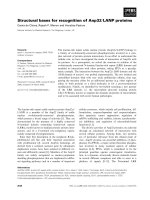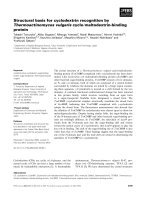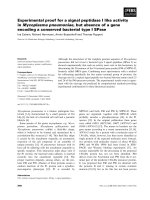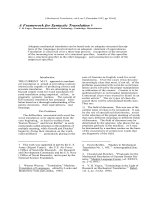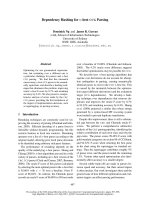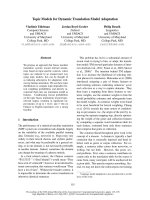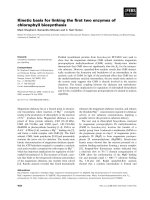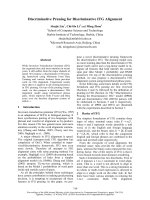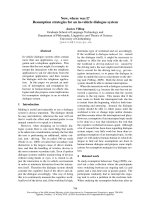Báo cáo khoa học: "Targeted Help for Spoken Dialogue Systems: intelligent feedback improves naive users'''' performance" pdf
Bạn đang xem bản rút gọn của tài liệu. Xem và tải ngay bản đầy đủ của tài liệu tại đây (521.52 KB, 8 trang )
Targeted Help for Spoken Dialogue Systems:
intelligent feedback improves naive users' performance
Beth Ann Hockey
Research Institute for Advanced
Computer Science (RIACS),
NASA Ames Research Center,
Moffet Field, CA 94035
Oliver Lemon
School of Informatics,
University of Edinburgh,
2 Buccleugh Place
Edinburgh EH8 9LW, UK
Ellen Campana
Laura Hiatt
Gregory Aist
Department of Brain Center for the Study of Language
RIACS
and Cognitive Sciences
and Information (CSLI) NASA Ames Research Center,
University of Rochester
Stanford University
Moffet Field, CA 94035
Rochester, NY 14627
210 Panama St,
.edu
Stanford, CA 94305
John Dowding
RIACS
NASA Ames Research Center,
Moffet Field, CA 94035
James Hieronymus
RIACS
NASA Ames Research Center,
Moffet Field, CA 94035
Alexander Gruenstein
BeVocal, Inc.
685 Clyde Avenue
Mountain View, CA 94043
Abstract
We present experimental evidence that
providing naive users of a spoken dia-
logue system with immediate help mes-
sages related to their out-of-coverage ut-
terances improves their success in using
the system. A grammar-based recog-
nizer and a Statistical Language Model
(SLM) recognizer are run simultane-
ously. If the grammar-based recognizer
suceeds, the less accurate SLM recog-
nizer hypothesis is not used. When the
grammar-based recognizer fails and the
SLM recognizer produces a recognition
hypothesis, this result is used by the Tar-
geted Help agent to give the user feed-
back on what was recognized, a diag-
nosis of what was problematic about the
utterance, and a related in-coverage ex-
ample. The in-coverage example is in-
tended to encourage alignment between
user inputs and the language model of
the system. We report on controlled ex-
periments on a spoken dialogue system
for command and control of a simulated
robotic helicopter.
1 Introduction
Targeted Help makes use of user utterances that
are out-of-coverage of the main dialogue system
recognizer to provide the user with immediate
feedback, tailored to what the user said, for cases
in which the system was not able to understand
their utterance. These messages can be much more
informative than responding to the user with some
variant of "Sorry I didn't understand", which is
the behaviour of most current mixed initiative di-
alogue systems. Providing relevant help messages
is a non-trivial problem with mixed initiative sys-
tems. There is a much wider range of utterances
that the user could sensibly say to a mixed initia-
tive system at any give point in a dialogue. In ad-
dition since the system must determine rather than
dictate the dialogue state there is uncertainty about
the context in which help needs to be given. Our
Targeted Help approach is aimed at addressing this
147
problem using information that can reasonably be
extracted from imperfect input.
To implement Targeted Help we use two rec-
ognizers: the Primary Recognizer is constructed
with grammar-based language model and the Sec-
ondary Recognizer used by the Targeted Help
module is constructed with a Statistical Language
Model (SLM). As part of a spoken dialogue sys-
tem, grammar based recognizers tuned to a do-
main perform very well, in fact better than com-
parable Statistical Language Models (SLMs) for
in-coverage utterances (Knight et al., 2001). How-
ever, in practice users will sometimes produce ut-
terances that are out of coverage. This is particu-
larly true of non-expert users, who do not under-
stand the limitations and capabilities of the sys-
tem, and consequently produce a much lower per-
centage of in-coverage utteraces than expert users.
The Targeted Help strategy for achieving good
performance with a dialogue system is to use a
grammar-based language model and assist users
in becoming expert as quickly as possible. This
approach takes advantage of the strengths of both
types of language models by using the grammar
based model for in-coverage utterances and the
SLM as part of the Targeted Help system for out-
of-coverage utterances.
In this paper we report on controlled experi-
ments, testing the effectiveness of an implementa-
tion of Targeted Help in a mixed initiative dialogue
system to control a simulated robotic helicopter.
2 System Description
2.1 The WITAS Dialogue System
Targeted Help was deployed and tested as part
of the WITAS dialogue system
l
, a command and
control and mixed-initiative dialogue system for
interacting with a simulated robotic helicopter or
UAV (Unmanned Aerial Vehicle) (Lemon et al.,
2001). The dialogue system is implemented as
a suite of agents communicating though the SRI
Open Agent Architecture (OAA) (Martin et al.,
1998). The agents include: Nuance Communi-
cations Recognizer (Nuance, 2002); the Gemini
parser and generator (Dowding et al., 1993) (both
'See
/>and />witas
using a grammar designed for the UAV appli-
cation); Festival text-to-speech synthesizer (Sys-
tems, 2001); a GUI which displays a map of
the area of operation and shows the UAV's loca-
tion; the Dialogue Manager (Lemon et al., 2002);
the Robot Control and Report component, which
translates commands and queries bi-directionally
between the dialogue interface and the UAV. The
Dialogue Manager interleaves multiple planning
and execution dialogue threads (Lemon et al.,
2002).
While the helicopter is airborne, an on-board
active vision system will interpret the scene be-
low to interpret ongoing events, which may be re-
ported (via NL generation) to the operator. The
robot can carry out various activities such as fly-
ing to a location, fighting fires, following a ve-
hicle, and landing. Interaction in WITAS thus
involves joint-activities between an autonomous
system and a human operator. These are activ-
ities which the autonomous system cannot com-
plete alone, but which require some human inter-
vention (e.g. search for a vehicle). These activi-
ties are specified by the user during dialogue, or
can be initiated by the UAV. In any case, a major
component of the dialogue, and a way of maintain-
ing its coherence, is tracking the state of current
or planned activities of the robot. This system is
sufficiently complex to serve as a good testbed for
Targeted Help.
2.2 The Targeted Help Module
The Targeted Help Module is a separate compo-
nent that can be added to an existing dialogue
system with minimal changes to accomodate the
specifics of the domain. This modular design
makes it quite portable, and a version of this agent
is in fact being used in a second command and
control dialogue system (Hockey et al., 2002a;
Hockey et al., 2002b). It is argued in (Lemon
and Cavedon, 2003) that "low-level" processing
components such as the Targeted Help module are
an important focus for future dialogue system re-
search. Figure 1 shows the structure of the Tar-
geted Help component and its relationship to the
rest of the dialogue system.
The goal of the Targeted Help system is to han-
dle utterances that cannot be processed by the
148
Main Dialogue System
Parser
Primary
speech recognizer
Speech synthesizer
Dialogue manager
Secondary
speech recognizer
Targeted Help
activator
Targeted Help
agent
- -
Targeted Help Module
Speech in
Speech out
Normal response path
-A
Targeted Help response path
Targeted Help alternate path (if secondary SR result parses)
Figure 1: Architecture of Dialogue System with Targeted Help Module
usual components of the dialogue system, and to
align the user's inputs with the coverage of the sys-
tem as much as possible. To perform this function
the Targeted Help component must be able to de-
termine which utterances to handle, and then con-
struct help messages related to those utterances,
which are then passed to a speech synthesizer. The
module consists of three parts:
•
the Secondary Recognizer,
•
the Targeted Help Activator,
•
the Targeted Help Agent.
The Targeted Help Activator takes input from
both the main grammar-based recognizer and the
backup category-based SLM recognizer. It uses
this input to determine when the Targeted Help
component should produce a message. The Acti-
vator's behavior is as follows for the four possible
combinations of recognizer outcomes:
1.
Both recognizers get a recognition hypothe-
sis:
Targeted Help remains inactive; normal dia-
logue system processing proceeds
2.
Main recognizer gets a recognition hypothe-
sis and secondary recognizer rejects:
Targeted Help remains inactive; normal dia-
logue system processing proceeds
3.
Main recognizer rejects, secondary recog-
nizer gets a recognition hypothesis and sec-
ondary recognizer hypothesis can be parsed
(rare):
normal dialogue system processing continues
using the secondary recognizer output
4.
Main recognizer rejects, secondary recog-
nizer gets a recognition hypothesis and
secondary recognizer hypothesis cannot be
parsed :
Targeted Help is activated
5. Both recognizers reject:
Targeted Help is not activated, default system
failure message is produced
Once Targeted Help is activated, the Targeted
Help Agent constructs a message based on the
recognition hypothesis from the secondary SLM
recognizer. These messages are composed of one
or more of the following pieces:
What the system heard:
a report of the backup
SLM recognition hypothesis.
What the problem was:
a description of the
problem with the user's utterance (e.g. the
system doesn't know a word); and
What you might say instead:
A similar in-
coverage example.
149
In constructing both the diagnostic of the prob-
lem with the utterance, and the in-coverage exam-
ple, we are faced with the question of whether the
information from the secondary recognizer is suf-
ficient to produce useful help messages. Since this
domain is relatively novel, there is not very much
data for training the SLM and the performance re-
flects this. We have designed a rule based system
that looks for patterns in the recognition hypothe-
sis that seem to be detected adequately even with
incomplete or inaccurate recognition.
Diagnostics are of three major types:
•
endpointing errors,
•
unknown vocabulary,
•
subcategorization mistakes.
We found from an analysis of transcripts that
these three types of errors accounted for the ma-
jority of failed utterances. Endpointing errors are
cases of one or the other end of an utterance being
cut off. For example, when the user says "search
for the red car" but the system hears "for the red
car". We use information from the dialogue sys-
tem's parsing grammar (which has identical cover-
age to its speech recognizer) to determine whether
the initial word recognized for an utterance is a
valid initial word in the grammar. If not, the ut-
terance is diagnosed as a case of the user pressing
the push-to-talk button too late and the system re-
ports that to the user.
2
Out-of-vocabulary items
that can be identified by Targeted Help are those
that are in the SLM's vocabulary but are out of
coverage for the grammar based recognizer and so
cannot be processed by the dialogue system. For
these items Targeted Help produces a message of
the form "the system doesn't understand the word
X"
Saying "Zoom in on the red car" when the sys-
tem only has intransitive "zoom in" is an exam-
ple of a subcategorization error. In these cases the
word is in-vocabulary but has been used in a way
2
while this problem may seem peculiar to the use of push-
to-talk, in fact using another approach such as open micro-
phone simply introduces different endpointing (and other)
problems. Whatever system is employed, users will still need
to learn how it works to perform well with the system.
that is out-of-grammar. This is not simply a de-
ficiency of the grammar. In this case, for exam-
ple, zooming in on a particular object is not part
of the functionality of the system. To diagnose
subcategorization errors we consult the recogni-
tion/parsing grammar for subcategorization infor-
mation on in-vocabulary verbs in the secondary
recognizer hypothesis, then check what else was
recognized to determine if the right arguments are
there. For these types of errors the system pro-
duces a message such as "the system doesn't un-
derstand the word X used with
the red car".
These
diagnostics are one substantive difference from the
approach used in (Gorrell et al., 2002). The sim-
ple classifier approach used in that work to select
example sentences would not support these types
of diagnostics.
In constructing examples that are similar to the
user's utterance one issue is in what sense they
should be similar. One aspect we have looked
at is using in-coverage words from the user's ut-
terance. It is likely to help naive users learn
the coverage of the system if the examples give
them valid uses of in-coverage words they pro-
duced in their utterance. By using words from the
user's utterance the system provides both confir-
mation that those words are in coverage and an in-
coverage pattern to imitate. We believe that this
leads to greater linguistic alignment between the
user and the system. Another aspect of similar-
ity that we suspect is important is matching the
utterance dialogue-move type (e.g. wh-question,
yes/no-question, command) otherwise the user is
likely to be misled into thinking that a particular
type of dialogue-move is impossible in the system.
Looking for in-coverage words is fairly robust.
Even when the user produces an out-of-coverage
utterance they are likely to produce some in-
coverage words. The Targeted Help agent looks
for within-domain words in the recognition hy-
pothesis from the secondary SLM recognizer. This
gives us a set of target words from which to
match the example to the dialogue-move type of
the user's utterance: wh-question, yn-question, an-
swer, or command.
Furthermore, for commands (which are a large
percentage of the utterances) we use the in-
coverage words to produce a targeted in-coverage
150
example that is interpretable by the system. These
examples are intended to demonstrate how in-
vocabulary words from the backup recognizer hy-
pothesis could be successfully used in commu-
nicating with the system. For example, if the
user says something like "fly over to the hospi-
tal", where "over" is out-of-coverage, and the fall-
back recognizer detected the words "fly" and "hos-
pital", the Targeted Help agent could provide an
in-coverage example like "fly to the hospital". For
the other less frequent utterance types we have one
in coverage example per type. The system cur-
rently uses a look-up table but we hope to incor-
porate generation work which would support gen-
eration of these examples on the fly from a list of
in-coverage words (Dowding et al., 2002).
3 Design of Experiments
In order to assess the effectiveness of the targeted
help provided by our system, we compared the
performance of two groups of users, one that re-
ceived targeted help, and one that did not. Twenty
members of the Stanford University community
were randomly assigned to one of the two groups.
There were both male and female subjects, the ma-
jority of subjects were in their twenties and none
of the subjects had prior experience with spoken
dialogue systems. The structure of the interaction
with the system was the same for both groups.
They were given minimal written instruction on
how to use the system before the interaction be-
gan. They were then asked to use the system to
complete five tasks, in which they directed a heli-
copter to move within a city environment to com-
plete various task oriented goals which were dif-
ferent for four of the five tasks. For each task the
goals were given immediately prior to the start of
the interaction, in language the system could not
process to prevent users from simply reading the
goal aloud to the system. A given task ended when
one of the following criteria was met:
1.
the task was accurately completed and the
user indicated to the system that he or she had
finished,
2.
the user believed that the task was completed
and indicated this to the system when in fact
the task was not accurately completed, or
3. the user gave up.
The first and last of the sequence of five tasks
were the critical trials that were used to assess per-
formance. Both of the tasks had goals of the form
"locate an x and then land at the y" The experi-
ment was conducted in a single session. An exper-
imenter was present throughout, but when asked
she refused to provide any feedback or hints about
how to interact with the system.
As stated above, the critical difference between
the two groups of users was the feedback they re-
ceived during interaction with the system. When
the users in the No Help condition produced out-
of-coverage utterances the system responded only
with a text display of the message "not recog-
nized". In contrast, when users in the Help condi-
tion produced out-of-coverage utterances they re-
ceived in-depth feedback such as: "The system
heard
fly between the hospital and the school,
un-
fortunately it doesn't understand
fly
when used
with the words
between the hospital and the
school.
You could try saying fly
to the hospital."
We hypothesized that: 1) providing Targeted
Help would improve users' ability to complete
tasks
(HIGHER TASK COMPLETION);
and 2) time
to complete tasks would be reduced for users re-
ceiving Targeted Help
(REDUCED TIME).
We
also anticipated that both effects would be more
marked in the first task than in the fifth task
(LARGER EARLY EFFECT).
4 Experimental Results
We found clear evidence that targeted help im-
proves performance in this environment, as mea-
sured by both the frequency with which the user
simply explicitly gave up on a task, and the time
to complete the remaining tasks. In this section we
present the statistical analyses of the experiment.
For the following analyses two subjects, both in
the No Help condition, were excluded from the
analyses because they gave up on every task, leav-
ing 9 users in each of the two help conditions. Ex-
ceptions are noted.
We begin by examining the percentage of trials
in which users explicitly gave up on a task before
it was completed. We compared the percentage of
trials in which the user clicked the "give up" but-
151
ton in both tasks for users in both help conditions.
As predicted, a 1-within (Task), 1-between (Help
condition) subjects ANOVA revealed a main effect
of the help condition (F1(1,16)=6.000, p<.05).
Users who received targeted help were less likely
to give up than those who did not receive help, par-
ticularly during the first task (11% vs. 27%). If
we include the two subjects in the No Help con-
dition who gave up on every task the difference is
even more striking. For the first task only 11% of
the users who received help gave up, compared to
45% of the users who did not receive help. The
pattern holds up even if we include the three in-
tervening filler trials along with the experimental
trials, as demonstrated by a paired t-test item anal-
ysis (t(4) = 7.330, p<.05). Those who received
help were less likely to explicitly give up even on
this wider variety of tasks.
We next examine the time it took users to com-
plete the individual tasks. Here it is necessary to
be clear about what is meant by "completion." It
is more ambiguous than it may seem. Each task
had several sub-goals, and it was even difficult
to objectively evaluate whether a single sub goal
had been met. For instance, the goal of the first
task was to find a red car near the warehouse and
then land the helicopter. Users tended to indicate
that they had finished as soon as they saw the red
car, failing to land the helicopter as the instruc-
tions specified. Another common source of ambi-
guity was when the user saw the car on the map
but never brought it up in the dialogue, simply
landing the helicopter and clicking "finished." The
problem with this is that there is no way of know-
ing whether the user actually saw the car before
clicking finish, and there was no explicit record
that they were aware of its presence. For all tri-
als the experimenter evaluated the task comple-
tion, recording what was done and what was left
undone. According to the experimenter, in most
cases of potential ambiguity the basic goal was
completed. In a few instances, however, the user
indicated belief that the task had been completed
when it obviously had not. An example of this is
the following: The goal specified was to find a red
car near the warehouse and then land. The user
flew the helicopter to the police station, and then
clicked "finished," ending the task. We dealt with
the ambiguity problem by analyzing the time to
completion data separately according to two dif-
ferent inclusion criteria. In both cases the pattern
was the same: Users who received help took less
time to complete tasks than those who did not, the
first task took longer to complete than the last one,
and the difference between the help and no help
conditions was more marked on the first task than
on the last one.
In the first analysis we included all trials in
which the user clicked the "finished" button, re-
gardless of their actual performance. Subjects who
failed to complete one of the two critical tasks
(tasks 1 and 5) were excluded from the analysis.
We used a 1-within (Task), 1-between (Help con-
dition) subjects ANOVA. For task 1, 89% of the
trials in the Help condition and 55% of the trials
in the No Help were considered "completed." For
task 5, 100% of the trials in the Help condition and
80% of the trials in the No Help condition were
considered "completed:' The analysis revealed a
marginally significant main effect of the help con-
dition (F
1
(1,11) = 3.809, p<.1), a main effect of
task (F1,11=62.545, p <.001) and a help condition
by task interaction (F
1
(1,11)=10.203, p < .05).
The effects were in the predicted direction. Users
who received help took less time to complete tasks
than those who did not (290.4 seconds vs. 440.6
seconds), the first task took longer to complete
than the last one (365.5 seconds vs. 220.4 sec-
onds), and the difference between the help and no
help conditions was more marked on the first task
than on the last one (150.2 seconds vs. 94 sec-
onds). Figure 2 shows these results.
One criticism of this analysis is that it may in-
clude trials in which the task objectives were not
accurately completed before the subject clicked
"finished". We wished to avoid experimenter sub-
jectivity with respect to task completion, so we
conducted another analysis using the strictest in-
clusion criterion the experimental design allowed.
In this analysis we included only those trials in
which all task objectives were completed and
could be verified using the transcripts. This meant
that for all of the trials we included, the goal entity
was explicitly mentioned in the dialogue. Accord-
ing to this criterion only 44% of users in the Help
condition and 18% of users in the No Help con-
152
450
490
350
300
250
;% 290
150
100
50
0
500
450
SOO
350
1150
159
199
50
0
nflelp
UNo Help
Lenient Criterion Analysis
Strict Criterion Anaiysis
D !kip
•
No !Up
Task I
TaNk
T,01
Tail 5
Figure 2: Time to complete task under Lenient
Criterion for completion
Figure 3: Time to complete task under Strict Cri-
terion for completion
dition completed the first task. Similarly, 89% of
users in the Help condition and 40% of users in the
No Help condition accurately completed the task.
Although this analysis is conducted on sparse data,
it provides strong supporting evidence for the data
pattern observed in the more lenient analysis.
We examined the time it took to complete tasks
according to the strict criterion, excluding all other
trials. The ANOVA analysis was identical to the
previous one. It, too, revealed a main effect of
help condition (F
1
(1,3) = 15.438, p<.05), a main
effect of task (F1,3=83.512, p < .01), and a help
condition by task interaction (F1(1,3)=20.335, p
< .05). Again the effects were in the predicted di-
rection. Users who received help took less time to
complete tasks than those who did not (226.2 sec-
onds vs. 377.5 seconds), the first task took longer
to complete than the last one (379.9 seconds vs.
223.75), and the difference between the help and
no help conditions was more marked on the first
task than on the last one (190.4 seconds vs. 112.3
seconds). These results are shown in Figure 3.
5 Conclusions
We have shown that users benefit from having on-
line Targeted Help. Naive users who received
Targeted Help messages were less likely to give
up and significantly faster to complete tasks than
users who did not. Overall, those who did not
receive help gave up on 39% of the trials, while
those who received our Targeted Help only gave
up on 6% of the trials. With respect to time,
when we considered all trials in which the user
indicated that the goal had been completed (re-
gardless of performance), those users who did not
receive our Targeted Help took 53% longer than
those who did. Under stricter inclusion criteria,
which required the users to explicitly mention the
goal and accurately complete the task, the differ-
ence was even more pronounced. Those users who
did not receive help took 67.0% longer to com-
plete the tasks than those who received our Tar-
geted Help. In both help conditions, performance
improved over the course of the experimental ses-
sion. However, the advantage conferred by help
merely diminished and did not disappear during
the session.
These findings are remarkable because they
demonstrate that it is possible to construct ef-
fective Targeted Help messages even from fairly
low quality secondary recognition. Moreover, the
study suggests that such an approach can improve
the speed of training for naive users, and may re-
sult in lasting improvements in the quality of their
understanding.
6 Future Work
This work suggests many interesting directions for
further research. One area of investigation is the
contribution of various factors in the effectiveness
of the Targeted Help message for example:
•
What benefit is due to the online nature of the
help?
•
What benefit is due to the information con-
tent?
153
• What is the relative contribution of the vari-
ous parts of the Targeted Help message to the
improvement in user performance.
—
Is the diagnostic alone more or less ef-
fective than the example alone?
—
How much does getting the back up rec-
ognizer hypothesis help the user?
—
What is the most effective combination
of these components?
Another interesting direction is to look at effec-
tiveness across different types of applications. The
fact that we found positive results in this domain
and that (Gorrell et al., 2002) also found a variant
of Targeted Help useful on a quite different do-
main suggests that the approach could be generally
useful for a variety of types of dialogue systems.
We are currently looking at porting our Targeted
Help agent to additional domains.
Acknowledgements
This work was partially funded by the Wallenberg
Foundation's WITAS project, Linkoping Univer-
sity, Sweden and partially funded through
RI-
ACS under NASA Cooperative Agreement Num-
ber NCC 2-1006.
References
J. Dowding, M. Gawron, D. Appelt, L. Cherny,
R. Moore, and D. Moran. 1993. Gemini
.
A nat-
ural language system for spoken language under-
standing. In
Proceedings of the Thirty-First Annual
Meeting of the Association for Computational Lin-
guistics.
J. Dowding, G. Aist, B.A. Hockey, and E. 0. Bratt.
2002. Generating canonical examples using candi-
date words. In
(under submission).
G. Correll, I. Lewin, and M. Rayner. 2002. Adding
intelligent help to mixed-initiative spoken dialogue
systems. In
Proceedings of the Seventh Interna-
tional Conference on Spoken Language Processing
(ICSLP),
Denver, CO.
B.A. Hockey, G. Aist,
J.
Dowding, and
J.
Hieronymus.
2002a. Targeted help and dialogue about plans. In
Proceedings of the 40th Annual Meeting of the Asso-
ciation for Computational Linguistics (demo track),
Philadelphia, PA.
B.A. Hockey, G. Aist, J. Hieronymus, 0. Lemon, and
J.
Dowding. 2002b. Targeted help: Embedded train-
ing and methods for evaluation. In
Intelligent Tutor-
ing Systems (ITS) Workshop on Empirical Methods,
San Sebastian, Spain.
S. Knight, G. Gorrell, M. Rayner, D. Milward, R. Koel-
ing, and I. Lewin. 2001. Comparing grammar-based
and robust approaches to speech understanding: a
case study. In
Proceedings of Eurospeech 2001,
pages 1779-1782, Aalborg, Denmark.
Oliver Lemon and Lawrence Cavedon. 2003. Multi-
level architectures for natural-activity-oriented dia-
logues. In
Proceedings of EACL 2003 workshop
on Dialogue Systems: interaction, adaptation and
styles of management,
page (in press).
Oliver Lemon, Anne Bracy, Alexander Gruenstein, and
Stanley Peters. 2001. Information states in a multi-
modal dialogue system for human-robot conversa-
tion. In Peter Kiihnlein, Hans Reiser, and Henk Zee-
vat, editors, 5th Workshop on Formal Semantics and
Pragmatics of Dialogue (Bi-Dialog 2001),
pages 57
— 67.
Oliver Lemon, Alexander Gruenstein, and Stanley Pe-
ters. 2002. Collaborative activities and multi-
tasking in dialogue systems.
Traitement Automa-
ague des Langues (TAL),
43(2):131 — 154. Special
Issue on Dialogue.
D. Martin, A. Cheyer, and D. Moran. 1998. Build-
ing distributed software systems with the open agent
architecture. In
Proceedings of the Third Interna-
tional Conference on the Practical Application of In-
telligent Agents and Multi-Agent Technology,
Black-
pool, Lancashire, UK.
Nuance, 2002.
. As of 1 Feb
2002.
The Festival Speech Synthesis Systems, 2001.
/>. As of 28
February 2001.
154

